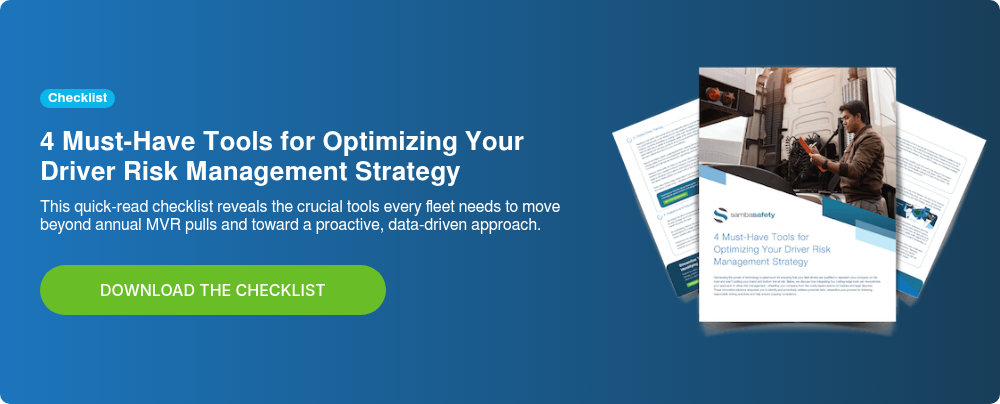5 Must-Share Driver Safety Tips for Employees That Every Safety Pro Needs

The average long-haul trucker is expected to log somewhere between 2,000 – 3,000 miles a week due to regulation restraints. It’s not just truckers that can spend long days behind the wheel though. In a time where roadway travel continues to gain momentum and streams of traffic are steadily increasing, it’s important to know that many of your drivers are planning and going on long-haul trips.
Did you know that, if your company has a self-reporting policy, it has the potential to open your business up to immense risk? Companies have the potential to be found liable if one of their drivers got in a crash or received a bad violation while driving on a road-trip, failed to self-report and continued driving on company time.
Knowledge like this make it so important to ensure that your safest drivers you have are engaging in low-risk behaviors off the clock instead of just while driving work hours. That includes long trips – both personal and professional – that your company’s drivers that are taking.
To help keep not only your drivers safer but also your business and bottom line protected, we recommend sharing these five safety tips. They’ll help properly ensure your drivers are equipped to be behind the wheel and navigate everyday roadway perils with ease.
Five Driver Safety Tips for Employees Hitting the Open Road
Plan for the Long-Haul
Before your drivers hitting the road, it’s worthwhile to look at how many miles it’ll take from point A to point B. If they’re in a passenger car, divide that number by 50 mph to determine how long it will take to get there.
When you tell them this, their first reaction may be: that sounds ridiculously slow, especially with highway speeds typically around 75 mph. Think about all the additional variables though – they’ll most likely have to stop for refueling, snacks, bathroom breaks, traffic, weather or even points of entry, if applicable.
Planning a road trip ahead of time helps budget time and expenses more effectively. Keep gas prices top of mind as well. With handy apps that can help find the cheapest places to stop, even saving 10 cents per gallon on gas can be a small difference that adds up to hundreds of dollars over time.
Eat Smarter, Not Faster
We all know that it’s not feasible to get by forever on food from diners, drive-thrus or truck stops. Instead, drivers on long-haul trips are often sitting down all day long and need to pay attention to what they eat. Luckily, with accessibility of healthier snacks at an all-time high, drivers can find it easier to discover alternatives to cheap and unhealthy foods when on the road.
When it comes to eating healthy, quick stops into grocery stores could be a driver’s new best friend. After all, what they eat on a road trip matters. Driving hundreds of miles on the open road can be boring and it’s not unrealistic to eat an entire bag of potato chips in a day without a thought. For a healthier choice, drivers should keep a supply of high-protein snacks like beef jerky, trail mix, protein shakes or almonds that will sustain them without degrading their health.
Maintain a Regular Schedule
The hours one drives are determined by themselves and as we all know, this can be a bad thing. We’ve all felt compelled to add on “just one more hour” to a long road trip in the hopes of just getting to our destination, all the while fighting sleep. While some people prefer to drive later and skip morning rush hours due to the roads being clearer, others prefer to drive at night.
Each has their positives and negatives. While at times a driver can get from point A to point B in the morning faster, they run the risk of being groggy and less than alert. Once again, drivers run into the same perils with driving at night. Even with 60 percent fewer cars on the road at night, more than 40 percent of crashes happen after dark.
Keep the Body Moving
Sitting still all day isn’t good for the body. It’s easy to forget about exercising if your drivers are behind the wheel for a whopping 14-hour trek but encourage them to prioritize exercise for their long-term health.
Share these tricks with your drivers: when stopping for fuel, make sure they know to stand on their feet; encourage stretches and staying limber during brief stops; if possible, give them the insight that short walks if possible are great for keeping the brain engaged and sharp.
Stop When it’s Time to Ttop
Let your drivers know that they won’t get to their destination any faster if they get in a crash or if push on while fatigued. If they’re driving in somewhere more treacherous and possibly unfamiliar such as the mountains, they must pay special attention to steep grades.
If they’re on a flat road, ensure they check in with themselves to make sure they aren’t getting road blindness. Road awareness is key in keeping those both operating the vehicle and the people they’re sharing the roadways with safer. One of the biggest tricks of the trade? It’s simple – don’t speed.
Keep Your Drivers (and Others) Safer
Keeping your drivers agile and aware will only benefit your company, even if they aren’t on the clock or driving on behalf of the company. Knowing that your drivers can present risk even on when doing things like taking road trips, it’s integral to provide them with useful tips to encourage safe driving for every circumstance.
To learn how professionals like yourself can better understand the risk your drivers present and see how they stack up, download our checklist.




